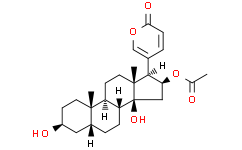Physicochemical Properties
| Molecular Formula | C26H36O6 |
| Molecular Weight | 444.5604 |
| Exact Mass | 444.251 |
| CAS # | 471-95-4 |
| Related CAS # | 471-95-4 |
| PubChem CID | 12302120 |
| Appearance | White to off-white solid |
| Density | 1.3±0.1 g/cm3 |
| Boiling Point | 591.7±50.0 °C at 760 mmHg |
| Melting Point | 223°C (rough estimate) |
| Flash Point | 195.8±23.6 °C |
| Vapour Pressure | 0.0±3.8 mmHg at 25°C |
| Index of Refraction | 1.587 |
| LogP | 2.54 |
| Hydrogen Bond Donor Count | 2 |
| Hydrogen Bond Acceptor Count | 6 |
| Rotatable Bond Count | 3 |
| Heavy Atom Count | 32 |
| Complexity | 878 |
| Defined Atom Stereocenter Count | 9 |
| SMILES | O([H])[C@]12C([H])([H])[C@@]([H])([C@]([H])(C3=C([H])OC(C([H])=C3[H])=O)[C@@]1(C([H])([H])[H])C([H])([H])C([H])([H])[C@]1([H])[C@@]3(C([H])([H])[H])C([H])([H])C([H])([H])[C@@]([H])(C([H])([H])[C@@]3([H])C([H])([H])C([H])([H])[C@@]21[H])O[H])OC(C([H])([H])[H])=O |
| InChi Key | VOZHMAYHYHEWBW-NVOOAVKYSA-N |
| InChi Code | InChI=1S/C26H36O6/c1-15(27)32-21-13-26(30)20-6-5-17-12-18(28)8-10-24(17,2)19(20)9-11-25(26,3)23(21)16-4-7-22(29)31-14-16/h4,7,14,17-21,23,28,30H,5-6,8-13H2,1-3H3/t17-,18+,19+,20-,21+,23+,24+,25-,26+/m1/s1 |
| Chemical Name | [(3S,5R,8R,9S,10S,13R,14S,16S,17R)-3,14-dihydroxy-10,13-dimethyl-17-(6-oxopyran-3-yl)-1,2,3,4,5,6,7,8,9,11,12,15,16,17-tetradecahydrocyclopenta[a]phenanthren-16-yl] acetate |
| Synonyms | Bufotalin |
| HS Tariff Code | 2934.99.9001 |
| Storage |
Powder-20°C 3 years 4°C 2 years In solvent -80°C 6 months -20°C 1 month |
| Shipping Condition | Room temperature (This product is stable at ambient temperature for a few days during ordinary shipping and time spent in Customs) |
Biological Activity
| ln Vitro |
Bufotalin (0.1-2.5 μM; 12-96 hours) treatment dose- and time-dependently inhibits MG-63 osteoblastoma cell survival[1]. Bufotalin (0.5-2.5 μM; 48 hours) treatment increases the percentage of Annexin V positive cells (apoptotic cells) and caspase-12 activity in MG-63 cells in a dose-dependent manner. Caspase-12 activation is linked to bufotalin-induced osteoblastoma cell apoptosis[1]. Bufotalin (0.5-2.5 μM; 12 hours) treatment dose-dependently induces C/EBP homologous protein (CHOP) expression as well as PERK and IRE1 phosphorylation in MG-63 cells. Bufotalin causes cells to activate their ER under stress[1]. Bufotalin treatment causes cell cycle arrest at G2/M phase in HepG2 cells by up-regulating p53 and p21 and down-regulating Aurora A, CDC25, CDK1, cyclin A, and cyclin B1. Bufotalin treatment also causes apoptosis, which was accompanied by alterations in the expression of bcl-2 and bax as well as changes in the levels of intracellular calcium and reactive oxygen species as well as activations of caspase-9 and -3. |
| ln Vivo | Bufotalin (0.5-1 mg/kg; intraperitoneal injection; twice daily; for 7 days) treatment intraperitoneal injection) significantly slows the growth of tumors in mice[1]. |
| References |
[1]. Bufotalin-induced apoptosis in osteoblastoma cells is associated with endoplasmic reticulum stress activation. Biochem Biophys Res Commun. 2014 Aug 15;451(1):112-8. [2]. Bufotalin from Venenum Bufonis inhibits growth of multidrug resistant HepG2 cells through G2/M cell cycle arrest and apoptosis. Eur J Pharmacol. 2012 Oct 5;692(1-3):19-28. |
| Additional Infomation |
Bufotalin is a steroid lactone. It is functionally related to a bufanolide. Bufotalin has been reported in Phrynoidis asper, Bufo gargarizans, and other organisms with data available. |
Solubility Data
| Solubility (In Vitro) | DMSO: ~100 mg/mL (~224.9 mM) |
| Solubility (In Vivo) |
Solubility in Formulation 1: ≥ 2.5 mg/mL (5.62 mM) (saturation unknown) in 10% DMSO + 40% PEG300 + 5% Tween80 + 45% Saline (add these co-solvents sequentially from left to right, and one by one), clear solution. For example, if 1 mL of working solution is to be prepared, you can add 100 μL of 25.0 mg/mL clear DMSO stock solution to 400 μL PEG300 and mix evenly; then add 50 μL Tween-80 to the above solution and mix evenly; then add 450 μL normal saline to adjust the volume to 1 mL. Preparation of saline: Dissolve 0.9 g of sodium chloride in 100 mL ddH₂ O to obtain a clear solution. Solubility in Formulation 2: ≥ 2.5 mg/mL (5.62 mM) (saturation unknown) in 10% DMSO + 90% (20% SBE-β-CD in Saline) (add these co-solvents sequentially from left to right, and one by one), clear solution. For example, if 1 mL of working solution is to be prepared, you can add 100 μL of 25.0 mg/mL clear DMSO stock solution to 900 μL of 20% SBE-β-CD physiological saline solution and mix evenly. Preparation of 20% SBE-β-CD in Saline (4°C,1 week): Dissolve 2 g SBE-β-CD in 10 mL saline to obtain a clear solution. Solubility in Formulation 3: ≥ 2.5 mg/mL (5.62 mM) (saturation unknown) in 10% DMSO + 90% Corn Oil (add these co-solvents sequentially from left to right, and one by one), clear solution. For example, if 1 mL of working solution is to be prepared, you can add 100 μL of 25.0 mg/mL clear DMSO stock solution to 900 μL of corn oil and mix evenly. (Please use freshly prepared in vivo formulations for optimal results.) |
| Preparing Stock Solutions | 1 mg | 5 mg | 10 mg | |
| 1 mM | 2.2494 mL | 11.2471 mL | 22.4942 mL | |
| 5 mM | 0.4499 mL | 2.2494 mL | 4.4988 mL | |
| 10 mM | 0.2249 mL | 1.1247 mL | 2.2494 mL |
